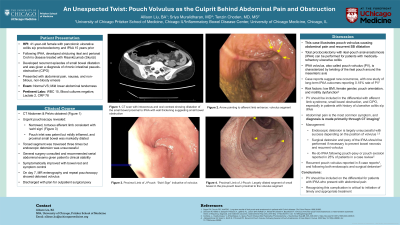Monday Poster Session
Category: IBD
P2700 - Unexpected Twist: Pouch Volvulus as the Culprit Behind Abdominal Pain and Obstruction in IBD
Monday, October 28, 2024
10:30 AM - 4:00 PM ET
Location: Exhibit Hall E

Has Audio

Allison Liu, BA
University of Chicago Pritzker School of Medicine
Chicago, IL
Presenting Author(s)
Allison Liu, BA1, Sriya Muralidharan, MD2, Tenzin Choden, MD, MS2
1University of Chicago Pritzker School of Medicine, Chicago, IL; 2University of Chicago Medicine, Inflammatory Bowel Disease Center, Chicago, IL
Introduction: Pouch volvulus (PV) is characterized by twisting of the ileal pouch following total proctocolectomy and IPAA (Ileal Pouch-Anal Anastomosis) surgery for ulcerative colitis. It is rare, challenging to diagnose, and successful detorsion depends on volvulus position. We report a case of PV presenting with pain and vomiting in a patient with an IPAA.
Case Description/Methods: A 41 year old female presented with abdominal pain, nausea, and vomiting. She had pancolonic ulcerative colitis for which she underwent proctocolectomy and IPAA fifteen years prior to presentation. However, following IPAA she developed stricturing ileal and perianal Crohn’s disease. Prior to presentation, she had recurrent episodes of small bowel (SB) dilatation and was diagnosed with chronic intestinal pseudo-obstruction (CIPO). She is treated with risankizumab but had been taking this intermittently.
Given her acute symptoms, she underwent CT abdomen pelvis with intravenous and oral contrast that showed dilatation around the IPAA associated with focal wall thickening, concerning for acute inflammation and mechanical obstruction. Urgent pouchoscopy showed a tortuous and narrowed entrance to the afferent limb of the pouch consistent with a “swirl sign.” The pouch inlet was patent but mildly inflamed. Distal to this segment, the SB was markedly dilated but had normal mucosa. These findings were suggestive of volvulus. The segment was traversed thrice but endoscopic de-torsion was unsuccessful. Surgical consultation recommended serial abdominal exams for monitoring given clinical stability. Symptoms improved with bowel rest and pain control. Seven days after presentation, MR enterography and repeat pouchoscopy showed detorsed volvulus. She was discharged with outpatient plan for surgical pexy.
Discussion: Our case illustrates PV causing abdominal pain and recurrent SB dilatation. This diagnosis should be included in the differential along with afferent limb syndrome, SB obstruction, and CIPO. Case reports suggest rare occurrence, with one study of long-term outcomes of IPAA with 0.18% rate of PV. Abdominal pain is the most common symptom and diagnosis is made primarily through CT imaging. Endoscopic detorsion is largely unsuccessful, and surgical detorsion and pexy of the IPAA should be performed to prevent bowel necrosis and recurrent volvulus. Re-do IPAA has been reported in 25% of patients in a case review. Recognizing this complication in patients with an IPAA is critical to initiation of timely and appropriate treatment.

Disclosures:
Allison Liu, BA1, Sriya Muralidharan, MD2, Tenzin Choden, MD, MS2. P2700 - Unexpected Twist: Pouch Volvulus as the Culprit Behind Abdominal Pain and Obstruction in IBD, ACG 2024 Annual Scientific Meeting Abstracts. Philadelphia, PA: American College of Gastroenterology.
1University of Chicago Pritzker School of Medicine, Chicago, IL; 2University of Chicago Medicine, Inflammatory Bowel Disease Center, Chicago, IL
Introduction: Pouch volvulus (PV) is characterized by twisting of the ileal pouch following total proctocolectomy and IPAA (Ileal Pouch-Anal Anastomosis) surgery for ulcerative colitis. It is rare, challenging to diagnose, and successful detorsion depends on volvulus position. We report a case of PV presenting with pain and vomiting in a patient with an IPAA.
Case Description/Methods: A 41 year old female presented with abdominal pain, nausea, and vomiting. She had pancolonic ulcerative colitis for which she underwent proctocolectomy and IPAA fifteen years prior to presentation. However, following IPAA she developed stricturing ileal and perianal Crohn’s disease. Prior to presentation, she had recurrent episodes of small bowel (SB) dilatation and was diagnosed with chronic intestinal pseudo-obstruction (CIPO). She is treated with risankizumab but had been taking this intermittently.
Given her acute symptoms, she underwent CT abdomen pelvis with intravenous and oral contrast that showed dilatation around the IPAA associated with focal wall thickening, concerning for acute inflammation and mechanical obstruction. Urgent pouchoscopy showed a tortuous and narrowed entrance to the afferent limb of the pouch consistent with a “swirl sign.” The pouch inlet was patent but mildly inflamed. Distal to this segment, the SB was markedly dilated but had normal mucosa. These findings were suggestive of volvulus. The segment was traversed thrice but endoscopic de-torsion was unsuccessful. Surgical consultation recommended serial abdominal exams for monitoring given clinical stability. Symptoms improved with bowel rest and pain control. Seven days after presentation, MR enterography and repeat pouchoscopy showed detorsed volvulus. She was discharged with outpatient plan for surgical pexy.
Discussion: Our case illustrates PV causing abdominal pain and recurrent SB dilatation. This diagnosis should be included in the differential along with afferent limb syndrome, SB obstruction, and CIPO. Case reports suggest rare occurrence, with one study of long-term outcomes of IPAA with 0.18% rate of PV. Abdominal pain is the most common symptom and diagnosis is made primarily through CT imaging. Endoscopic detorsion is largely unsuccessful, and surgical detorsion and pexy of the IPAA should be performed to prevent bowel necrosis and recurrent volvulus. Re-do IPAA has been reported in 25% of patients in a case review. Recognizing this complication in patients with an IPAA is critical to initiation of timely and appropriate treatment.

Figure: A) CT scan with intravenous and oral contrast showing signs of obstruction
B) Arrow pointing to afferent limb entrance, volvulus segment
C) Proximal Limb of J-Pouch: Volvulus
D) Proximal Limb of J-Pouch: Largely dilated segment of small bowel in the pre-pouch ileum proximal to the volvulus segment
B) Arrow pointing to afferent limb entrance, volvulus segment
C) Proximal Limb of J-Pouch: Volvulus
D) Proximal Limb of J-Pouch: Largely dilated segment of small bowel in the pre-pouch ileum proximal to the volvulus segment
Disclosures:
Allison Liu indicated no relevant financial relationships.
Sriya Muralidharan indicated no relevant financial relationships.
Tenzin Choden indicated no relevant financial relationships.
Allison Liu, BA1, Sriya Muralidharan, MD2, Tenzin Choden, MD, MS2. P2700 - Unexpected Twist: Pouch Volvulus as the Culprit Behind Abdominal Pain and Obstruction in IBD, ACG 2024 Annual Scientific Meeting Abstracts. Philadelphia, PA: American College of Gastroenterology.

